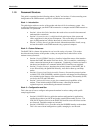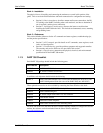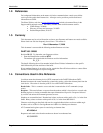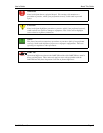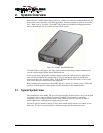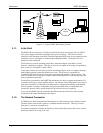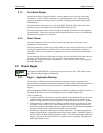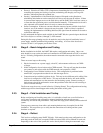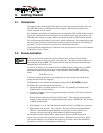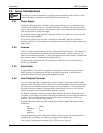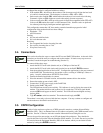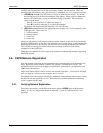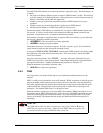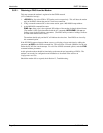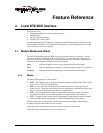
Introduction DART 300 Modem
Page 10 2110212 Rev 1.0
• Protocol. Selection of UDP or TCP is important to determining the best configuration for
controlling the opening and closing of sessions, maintaining data integrity over large file
transfers, and keeping network overhead low.
• Security. Implementation of the Friends Only feature will depend on the client/server
relationship and whether or not the central host will always use the same IP address. If there
is concern about improper access to the field device, and the DART 300 / local host can act as
a client, then the registration process could be handled manually. This means the local unit is
only connected to the network when it is ready to contact the remote host.
• Power Consumption. If there are concerns about the amount of power available in the field
locations, use of the modem’s sleep modes may be needed. If the local host is capable of
sleeping, the implementation of the Ring Indicator (RI) signal from the modem can be used to
control host wake-ups.
To fully understand the options made available by the DART 300, the system designer should read
the Feature Reference sections (4 through 7) of this manual.
During this first stage, planning may also be needed to resolve the physical installation issues of
power supply, antenna installation and grounding, and cabling. A review of the Installation
sections (10 and 11) will prepare you for these issues.
2.2.2. Stage 2 – Bench Integration and Testing
Before installation in the field, the DART 300 requires configuration and testing. One or two
units should be set-up on the test bench and connected to the CDPD network and a PC or terminal
device. Following configuration, the modem must be connected to the target host device and
tested.
There are several steps to this testing:
1. Physical connection to: a power supply, a host PC, and an antenna with access to CDPD
coverage.
2. Initial configuration for activation on the CDPD network. This step will test that the modem
can connect to, and register with, the CDPD network, and respond to a PING.
3. Configuration for use with the local host device. This configuration is performed with a
terminal (PC) to prepare the modem for use with the target device.
4. Connection and test with the local host device. This may involve different serial cabling if the
local host is configured as a DCE device. This step tests that the device will work with the
modem and communicate over the network to the monitoring system. Extensive testing of
fault tolerance should be performed to ensure that problems in the field are self-correcting or
can be corrected remotely.
The first two steps above are covered in Section 3, Getting Started. The configuration and testing
with the target device should happen after reading the balance of this guide.
2.2.3. Stage 3 – Field Installation and Testing
Before configuring and installing many units, it is advisable to install one or two field units to
verify power connection and consumption, antenna installation and network coverage,
connectivity, and end-to-end performance. Only when this stage passes should you rollout the full
system.
Custom power connectors, data cables, and mounting hardware may be required for the field
installation. This step allows you to verify that the connections are working and the system
functions as required.
2.2.4. Stage 4 – Rollout
This involves configuring many DART 300 units. Each must have the same configuration as the
units that passed the field trial; except the CDPD activation (NEI) will be different for each unit.
Depending on the scale of the system, this can be done by hand or through an automated script.



